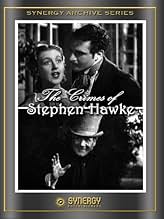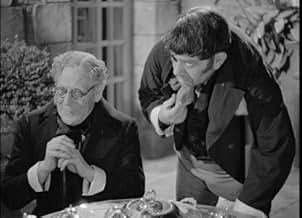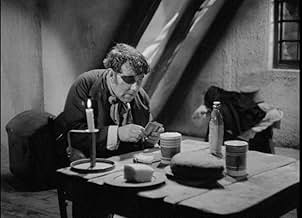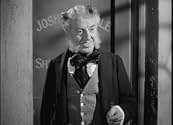A crazed killer known as "The Spinebreaker" is terrorizing London with a series of grisly murders. The police seem powerless to stop him.A crazed killer known as "The Spinebreaker" is terrorizing London with a series of grisly murders. The police seem powerless to stop him.A crazed killer known as "The Spinebreaker" is terrorizing London with a series of grisly murders. The police seem powerless to stop him.
Graham Soutten
- Nathaniel
- (as Ben Soutten)
B.C. Hilliam
- Self
- (as Flotsam)
Malcolm 'Mr. Jetsam' McEachern
- Self
- (as Jetsam)
Cecil Bevan
- Small Boy's Father
- (uncredited)
Annie Esmond
- Small Boy's Nanny
- (uncredited)
Jack Sharp
- Policeman
- (uncredited)
Harry Terry
- First Prisoner
- (uncredited)
Ben Williams
- Prison Warder
- (uncredited)
Featured reviews
THE CRIMES OF STEPHEN HAWKE opens with a rather lengthy radio program featuring the creaky musical duo, "Flotsam and Jetsam", and a man telling a story. Then, finally, Mr. Tod Slaughter himself arrives to recount some of his most devilish film roles.
When the actual story begins, we are introduced to the title character, known by the public at large as: The Spine Breaker (Mr. Slaughter). True to form, a victim is claimed within a few minutes. Hawke is presented as insidious right out of the gate! Mr. Slaughter once again portrays his villain as the embodiment of murderous glee.
Hawke also has a contrived persona as a kindly moneylender. No one suspects him of actually being a cackling psychopath, not even his daughter. This ruse helps to keep the entertainment level high, as we know full well what this monster is up to. There are some fun, sinister double entendres from Mr. Hawke about his crimes.
Fans of Tod Slaughter will love this film. The uninitiated will marvel at his ability to chew through scenery like a nuclear-powered buzz saw!...
When the actual story begins, we are introduced to the title character, known by the public at large as: The Spine Breaker (Mr. Slaughter). True to form, a victim is claimed within a few minutes. Hawke is presented as insidious right out of the gate! Mr. Slaughter once again portrays his villain as the embodiment of murderous glee.
Hawke also has a contrived persona as a kindly moneylender. No one suspects him of actually being a cackling psychopath, not even his daughter. This ruse helps to keep the entertainment level high, as we know full well what this monster is up to. There are some fun, sinister double entendres from Mr. Hawke about his crimes.
Fans of Tod Slaughter will love this film. The uninitiated will marvel at his ability to chew through scenery like a nuclear-powered buzz saw!...
Meandering tale of meek money lender Steven Hawke (Slaughter) who moonlights as a callous killer nicknamed "The Spine Breaker" for his bone crushing exploits. When his alter ego is exposed, he's forced to flee London, pursued by a relentless hunter but must make a daring return after hearing news that his daughter has been coerced into marrying a blackmailing prison warden.
Great comical thrills with the inimitable Tod Slaughter delivering his trademark psychopath with pompous relish. Eric Portman is the principal adversary and preferred suitor to the twisted killer's beloved daughter (Taylor), demonstrating the thespian skills for which he became better known throughout the next three decades.
If you're unaccustomed to the Tod Slaughter experience, then this I'd regard to be one of the better samples to gain a taste of the stage-borne flavour with which he interprets his twisted characterisations. The dialogue is poetic, loaded with double-entendres, witty quips and of course, hopelessly clichéd plot. Despite the low budget, it works like a charm, such is Slaughter's unique charisma and presence.
Great comical thrills with the inimitable Tod Slaughter delivering his trademark psychopath with pompous relish. Eric Portman is the principal adversary and preferred suitor to the twisted killer's beloved daughter (Taylor), demonstrating the thespian skills for which he became better known throughout the next three decades.
If you're unaccustomed to the Tod Slaughter experience, then this I'd regard to be one of the better samples to gain a taste of the stage-borne flavour with which he interprets his twisted characterisations. The dialogue is poetic, loaded with double-entendres, witty quips and of course, hopelessly clichéd plot. Despite the low budget, it works like a charm, such is Slaughter's unique charisma and presence.
You owe it to yourself to see at least one Tod Slaughter film. His signature movie Sweeney Todd, The Demon Barber of Fleet Street or the career overview Crimes at the Dark House are two of the best examples, but The Crimes of Stephen Hawke is a worthwhile introduction to his work. Like most of the early Slaughter movies it seems uneasy about the (then) new film medium favouring more common forms of entertainment. His debut film Maria Marten or the Murder in the Red Barn opens with the entire cast being introduced like in a play and Crimes opens like a radio show complete with some hard to watch variety acts (singers Flotsom and Jetsom and a `comic' butcher) before Tod Slaughter is brought on to introduce his latest piece of `Strong Meat'. In the subsequent film/ radio play Slaughter (real name: Norman Carter Slaughter) plays the title role, an outwardly respectable moneylender who is really serial killer `The Spinebreaker' nicknamed for his ability to snap his victim's spines. His long time friend Joshua becomes his latest victim, however upon discovering the guilty party Jossua's son seeks revenge, forcing Hawke and his sidekick, an eyepatch wearing, one legged hunchback to flee, leaving Hawke's adopted daughter in the blackmailing hands of an upper class `lecherous brute'. For a film that barely passes the hour mark this manages to cram allot in, including a fake `talking' corpse, Hawke sent to jail for a year (for stealing a loaf of bread!), the obligatory romance, the honest guy vs the slimey rich guy for Hawke's daughter's hand and even some unexpected sensitivity. Its worth noting that the British censors banned all horror films during the WW2 years, although this falls a few years short of the censor's ban, during that time Slaughter was still making `meldrodramas' with tent pegs pounded into heads, human flesh stuffed into meat pies and lines like `I'll feed your entrails to the pigs' that were far more lurid than any banned Hollywood horror movie. Crimes opens to a sadistic scene where a pompous child is attacked by Slaughter and has his back broken, such scenes like that are not common in British movies of the time. Equally don't look for sub-plots about people being tortured with whips in Ealing comedies. Yet Slaughter's performance is incredible, extremely theatrical and barnstorming par excellence. You can almost hear the boos from the audience as he exits a scene giggling and cackling after `coming to grips' with some unfortunate. Some of the berserk expressions he makes in this film as he breaks spines makes it hard to believe he hadn't completely lost his mind. Call it hammy or over the top, but you'll never forget it. The director George King deserves credit for preserving most of Slaughter's body of work on film (even if he doesn't do it very well). Seemingly more comfortable on stage than on film, Slaughter's movies are little more than filmed plays, with cardboard sets, minimal (if any) camera movement, and unexceptional repertory players. Slaughter is the only reason to watch any of his films, for further proof see King's other Slaughter-less films like The Case of the Frightened Lady (1941) the old magic simply isn't there. Tales from Slaughter's theatre days are both hilarious and the stuff of legend. Actresses not needed would dress as nurses (in case anyone died of a heart attack), while Slaughter reviled in the sort of grand guignol butchery that could never be shown on film and would walk around after the show in blood stained clothes. Whether all these tales are true its hard to know. My relatives remember seeing the guy `live' sometime in the Forties and the man himself definitely left an impression running around the audience covered in blood (actually beetroot juice), waving a big knife and offering to `polish people off'. Now dead for nearly half a century, Slaughter's films are the nearest we'll ever come to experiencing such mad genius first hand. Technically the movies should be unwatchable, but they exert a strange fascination that you'll have to see for yourself, there really hasn't been anything like them before or since.
This time around Tod Slaughter plays Mr. Stephen Hawke, a limping, kind-hearted bespectacled money lender by day with a beautiful, faithful daughter and the friendship of a local shipping agent and son, and by night he is the "spine-breaker," cruelest of all killers as he kills the rich for their money and treasure in a serial-like fashion. As with any Slaughter film, Slaughter is the main focal point of the film. The film is barely over an hour in length, but it has much to offer in plot. We have Slaughter kill a spoiled rich kid, trick a man into bringing an emerald to his home, kill his friend, and run from the vengeance of his son. Throw in some lecherous guy that wants to force Hawke's daughter into marriage and a hunchback for extra measure. The rest of the actors are adequate(or less than so) but they do not detract at all from the presence of Slaughter on film. His build, his speech, his whole demeanor brings life to each and every scene he is in. Is he a great actor? No, but he sure can grab your attention and keep a "grip" on it. As with many other Slaughter films, George King directs in workman-like style if nothing else. The beginning is set up like a radio play with some "entertainers" doing some kind of real bad vocal act prior to Slaughter coming on talking about his "new" old melodrama. Good old-fashioned fun!
The Crimes of Stephen Hawke (1936)
** 1/2 (out of 4)
London is under a crippling terror as people are being crushed to death by a man known as The Spinebreaker (Tod Slaughter).
THE CRIMES OF STEPHEN HAWKE starts out unlike any other movie that I can remember. It starts off at a radio station where we basically get a radio broadcast for the first seven or eight minutes and then we finally get to the main story. In a rather shocking manor, it starts off with a child being murdered.
This here was the third film Slaughter made following THE MURDER IN THE RED BARN and THE DEMON BARBER OF FLEET STREET. Britain had pretty much put a ban on American horror movies and these British films had to walk a careful line. With that said, this here makes the murder of a child all the more shocking. There are some rather graphic and violent deaths for the era, although they aren't bloody or gory. The sound effects and screams of the people being crushed are certainly the highlight of the picture.
As was often the case with these films, the main reason people watch them today is for the over-the-top and at times wacky performance by Slaughter. I don't know how to describe him other than saying he was like John Barrymore had he gone insane and had a mental breakdown to the point where he was a raving dog. Once again he's all over the place here and he really makes himself stand apart from the other actors. The other actors are good but they just can't overtake the all-mighty Slaughter.
As far as the film goes, it's certainly a bit better than the star's previous two films and a strong argument could be made that this here is about as entertaining as his horror pictures got.
** 1/2 (out of 4)
London is under a crippling terror as people are being crushed to death by a man known as The Spinebreaker (Tod Slaughter).
THE CRIMES OF STEPHEN HAWKE starts out unlike any other movie that I can remember. It starts off at a radio station where we basically get a radio broadcast for the first seven or eight minutes and then we finally get to the main story. In a rather shocking manor, it starts off with a child being murdered.
This here was the third film Slaughter made following THE MURDER IN THE RED BARN and THE DEMON BARBER OF FLEET STREET. Britain had pretty much put a ban on American horror movies and these British films had to walk a careful line. With that said, this here makes the murder of a child all the more shocking. There are some rather graphic and violent deaths for the era, although they aren't bloody or gory. The sound effects and screams of the people being crushed are certainly the highlight of the picture.
As was often the case with these films, the main reason people watch them today is for the over-the-top and at times wacky performance by Slaughter. I don't know how to describe him other than saying he was like John Barrymore had he gone insane and had a mental breakdown to the point where he was a raving dog. Once again he's all over the place here and he really makes himself stand apart from the other actors. The other actors are good but they just can't overtake the all-mighty Slaughter.
As far as the film goes, it's certainly a bit better than the star's previous two films and a strong argument could be made that this here is about as entertaining as his horror pictures got.
Did you know
- TriviaMarjorie Taylor's debut.
- Quotes
Joshua Trimble: Yes, my boy. When people talk of flint-hearted money-lenders, they can't have met Stephen!
- ConnectionsFeatured in Doom Asylum (1988)
Details
- Release date
- Country of origin
- Language
- Also known as
- Crimen y pasión
- Production company
- See more company credits at IMDbPro
- Runtime1 hour 9 minutes
- Color
- Sound mix
- Aspect ratio
- 1.37 : 1
Contribute to this page
Suggest an edit or add missing content

Top Gap
By what name was The Crimes of Stephen Hawke (1936) officially released in Canada in English?
Answer























